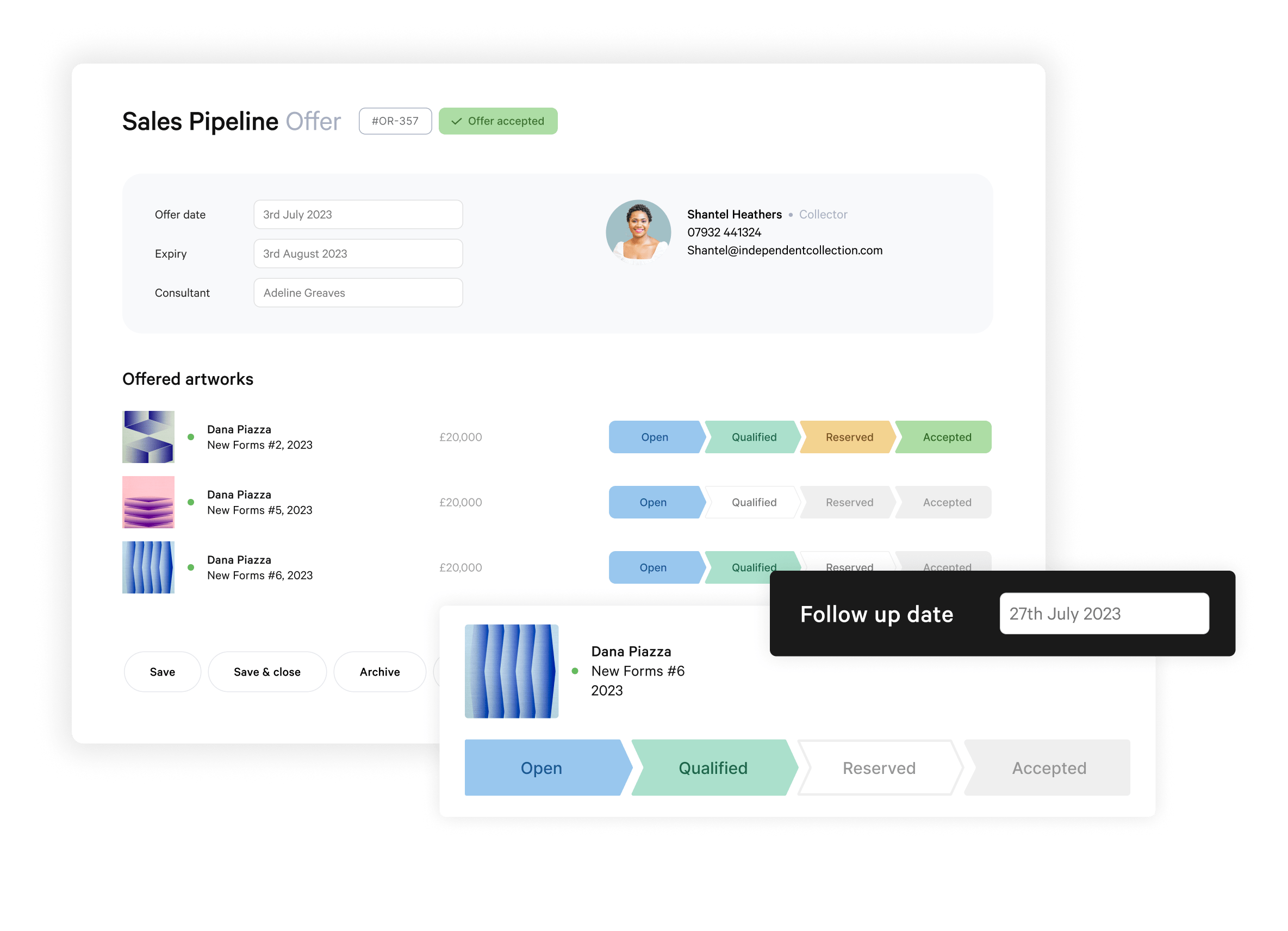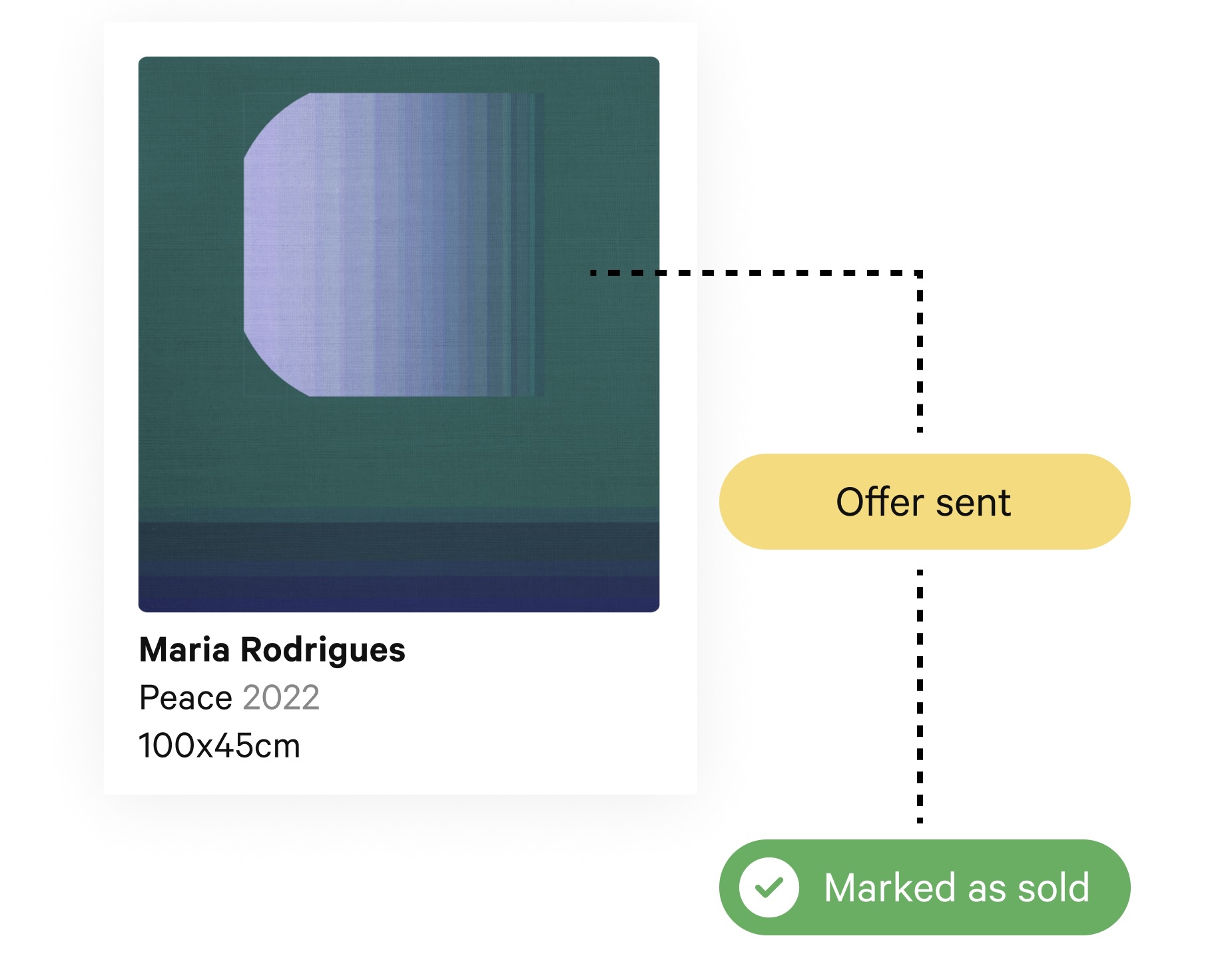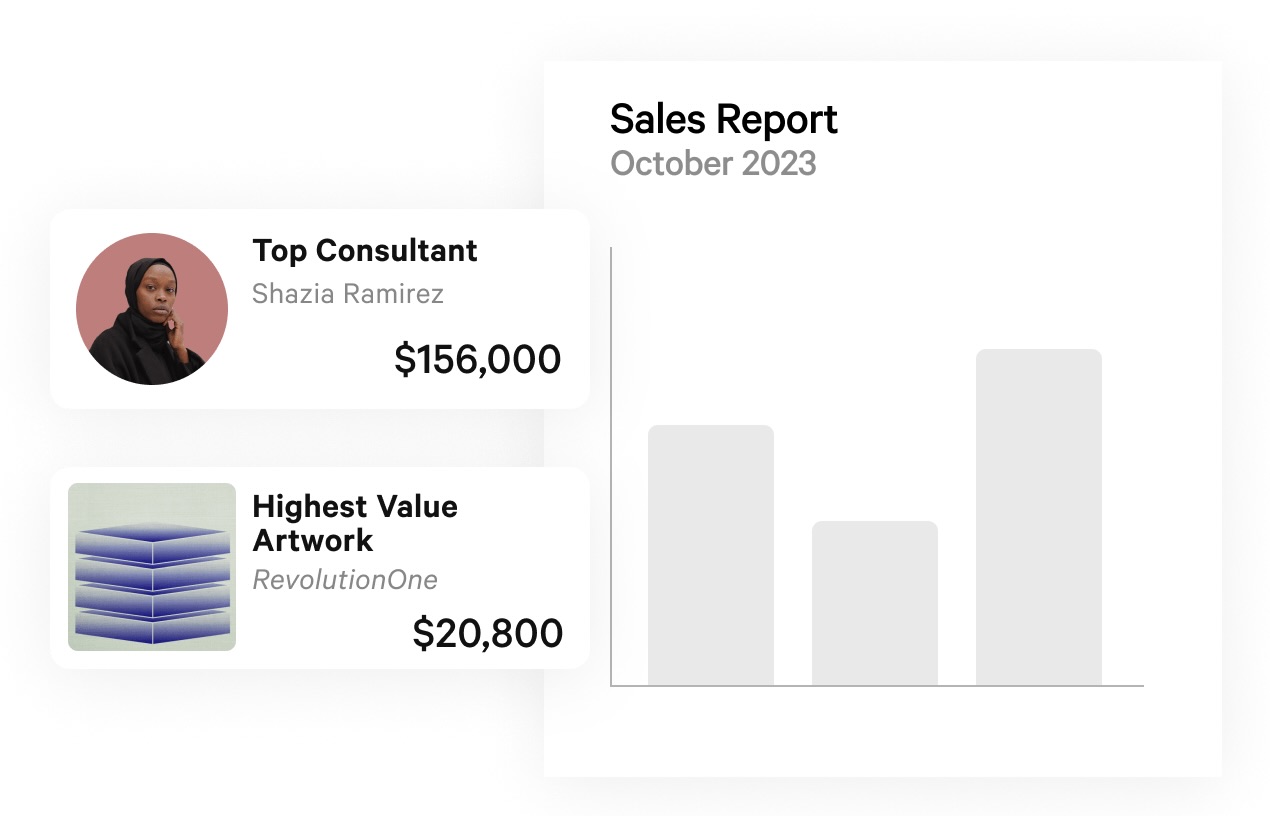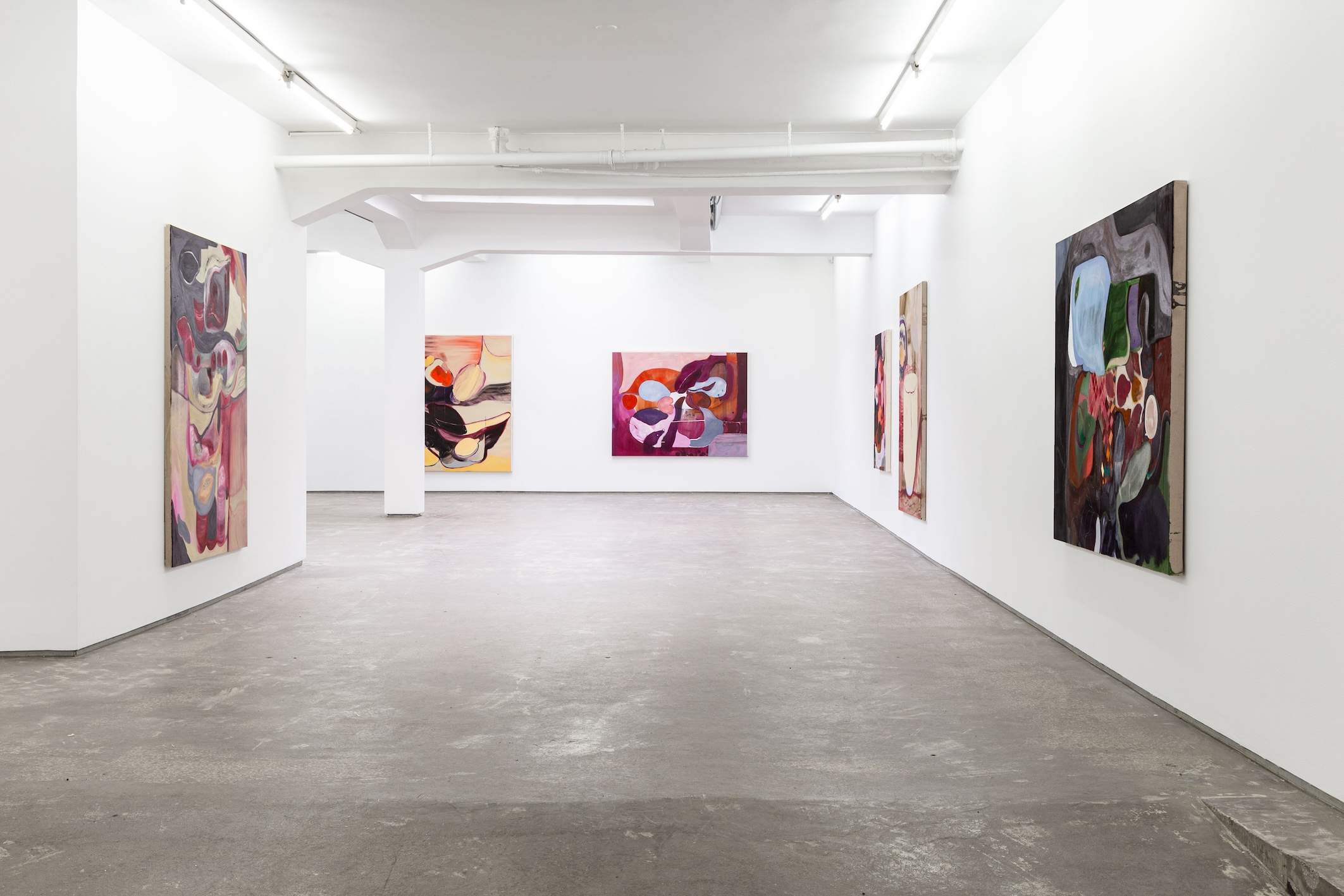6 minutes to read
Nurturing leads. Pursuing opportunities. Negotiating offers. Closing deals... All sounding familiar? As any seasoned salesperson in the art world will know, a prospective collector’s first engagement with an artwork is just the first in a long chain of interactions that lead to a purchase. And, to maximise your chances of success, a fully optimised sales strategy isn't just a nice-to-have, it's essential.
In this article, we journey down the sales funnel, from prospecting to closing, uncovering the secrets to a fully-optimised pipeline that'll transform art fair browsers into loyal customers.
But first… What is a sales pipeline?
A sales pipeline visualises a potential buyer’s journey through the sales process from prospect to buyer. This gives you a quick snapshot of which stage each deal is at, helping you to focus your efforts on the best opportunities and strategise effectively.For example, let’s say you meet a number of potential clients at an art fair. You take their details and add them to your database of contacts. As prospects, they’re now effectively at the first stage of your sales pipeline. When you follow up post-fair to gauge their interest in any particular work, you’re qualifying each lead – entering the second stage of your pipeline.
By using a dedicated art sales platform, it’s easy for you and your team to keep track of the status of each deal in a single shared workflow. You can arrange all of your prospects in one place, with details of who has shown interest in which pieces, which works have already been offered or reserved, create personalised offer emails, and assign key actions such as follow-up dates.
Sales pipeline benefits

The following benefits prove why every gallery should maintain a functional sales pipeline:
Improve sales performance
- an effective pipeline boosts performance. As well as streamlining the sales process to increase sales, this reduces admin and lost leads that can occur if your strategy is scattered across multiple, non-integrated platforms.
Improve collector relationships
- a more effective sales strategy improves client relationships by giving structure to your engagement with each prospect. You can label each one by when they were last contacted, their pending offers, and a follow up date. This helps to avoid frustrations like doubling up on conversations, contacting them too frequently, or forgetting to contact them entirely. Better relationships increase the chances of future sales.
Gather useful data
- by keeping track of all your deals, you can generate detailed reports that give you granular insight into your sales performance. These can be broken down by artist, country, and consultant, allowing you to turn insights into actions. For example, you might see new interest for a particular artist in Spain and decide to focus more resources on that market.
Better ROI and resource allocation
- Not only will you be able to turn prospects you’ve met at a fair into customers, but you’ll be able to see exactly how many leads from a particular fair turned into sales, helping you to understand whether the ROI was worth the expense of exhibiting and to dedicate more or less resources to those fairs in future.
Sales pipeline stages
 We’ve touched on some of the sales pipeline stages, but to fully optimise your sales strategy, you need to understand the buyer’s journey through the entire funnel.
We’ve touched on some of the sales pipeline stages, but to fully optimise your sales strategy, you need to understand the buyer’s journey through the entire funnel.-
Prospecting
prospecting is generating leads. For example, meeting prospects at an art fair who are interested in your works, taking their contact details, and adding them to your CRM platform. At this stage, all your recorded offers can be marked as Open, meaning there’s still a chance a deal won’t close and that it remains open to other offers. -
Lead qualifying
this stage determines how likely those leads are to actually purchase a specific work of art. It aims to filter out unsuitable prospects based on key characteristics so that you can focus your efforts on only those most likely to convert. You can create compelling offer emails within your pipeline software, tailored to the preferences of individual clients, and even share ‘Private View’ links that give them a highly curated online experience of pieces. -
Negotiating
if a client shows an interest in a particular work, you can make a note of it live on the art fair floor, or they can submit an enquiry through your website, and you can mark the offer as qualified. However, there’s still time for another client to make a counter offer. It’s then easy to organise each deal by status and update the offer as it moves through the process. -
Reserving
if a client decides that they want to shield an artwork from being sold to someone else, you can temporarily mark it as reserved in the sales funnel. -
Sale or loss
finally, if the client wants to move forward with the sale, you can create an invoice and arrange shipping from directly within your pipeline platform and mark the offer as sold. And, In a matter of clicks, Artlogic Pay will allow collectors to pay a deposit or invoice immediately and directly, without any hassle.
The inventory will then be automatically updated in multiple places so your team and website visitors can see that the piece is no longer available, or, if it’s a print or edition, that there are only a certain number remaining. Alternatively, the deal could fall though and you can revert the status of the offer to Open.
How to create a sales pipeline for your team
 Let’s look at how you can build a sales pipeline that helps your team to maximise sales.
Let’s look at how you can build a sales pipeline that helps your team to maximise sales.-
Decide your qualification criteria
The qualification stage involves identifying the most promising leads amongst all your prospects. Define a lead scoring system that determines how closely each lead aligns with your ideal customer profile based on demographics. -
Set targets
These can be very specific. For example, you could aim to sell 80% of the works you exhibit at the fair, more works by a particular artist or to close more deals off the back of leads from a particular art fair. Or they could be more general targets around overall revenue or improving your closing rate on last year’s art fair season. Whatever your targets, make sure that they align with your overall business goals. -
Outline actions for each stage
It’s vital to define actions and assign tasks at every stage of your pipeline. For example, at the qualifying stage, the salesperson should send an offer email that includes a link to a Private View of the works. Then they should do a follow up email or call. You could even outline post-deal actions to ensure good relationships with collectors are maintained. -
Use your data
Data is the bedrock of an optimised sales pipeline. Ideally, you should select a platform designed for the art market with a robust data and reporting function. That way you can automatically generate reports and access insights that can tell you whether you’re hitting your targets, and that can expose challenges or limitations of your sales strategy that you need to address.
Sales pipeline management
Pipeline management ensures you have a healthy flow of deals moving through your pipeline in the right direction. Here’s how to do it:-
Don’t neglect new leads –
don’t make the mistake of putting all your efforts into closing at the expense of sourcing new leads. Be proactive about finding new prospects through art fairs, contacting your database, and marketing via any channels that have proved fruitful to you in the past (like sending a newsletter, for example) -
Conduct regular reviews –
everyone responsible for the pipeline should meet regularly to review it. This is an opportunity to discuss existing deals and challenges, refine your strategy, and share ideas. -
Lose dead leads –
it can be hard to let go, but you should regularly remove deals that have gone cold. Sure, give them a nudge, but lose them if you don’t get a response to avoid clogging up your sales pipeline. -
Be consistent –
ensure that new gallery staff are trained properly to move deals through the sales pipeline and coordinate with their peers. A consistent approach will keep everything tidy, ensure no opportunities are missed, and avoids doubling up on work.
Before you go…
Make this your best art fair season yet by implementing an optimised sales pipeline strategy. Don’t let a warm lead go cold: quickly add new prospects to your system and engage them with a mass email sendout. Then qualify leads and personalise your approach to move them down the funnel towards a successful close.The Artlogic Sales Pipeline is designed specifically for the art world – helping you to streamline your sales process, manage client relationships, and boost your revenue.
September 15, 2023






